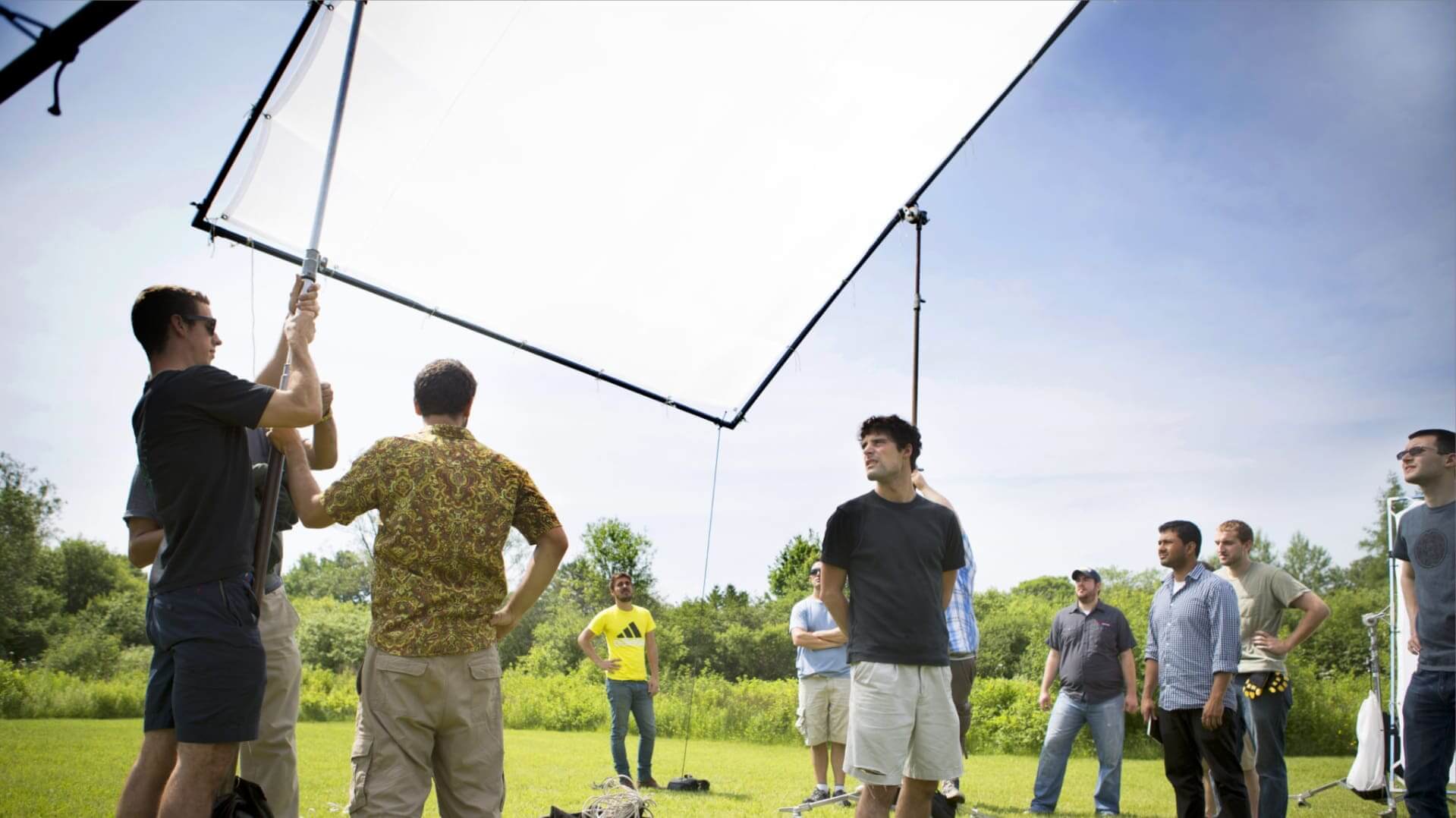The short answer to the question, “What is a Grip?” is that a Grip on a film crew is someone who moves lighting equipment around. But there’s more to being a Movie Grip than simply taking gear from one spot to another. In this post we’ll answer the questions “What is a Film Grip?” and “What does a Grip do?” We’ll look at what a Movie Grip actually does and what it takes to do one of the most demanding jobs on a film set. We’ll also talk about what you’ll need if you want to work a Grip job in the film industry.
What is a Movie Grip
First, let’s define Movie Grip
Part of understanding “What is a Grip” is knowing that there are actually a few different flavors of Grip on a movie set. But the main Grip job is to set up the equipment that shapes the light for each scene. Here's a proper Film Grip definition before we jump into the specifics of the role. For a complete guide to the major roles in film production, check out our ultimate guide to film crew positions.
GRIP DEFINITION Film
What is a Grip?
A Grip is responsible for setting up, rigging, and striking lighting equipment on set. They are also responsible for keeping equipment organized, and sometimes equipment maintenance. A Key Grip in film is the boss of the Grips department. And there are also Dolly Grips who assist the Camera department by physically moving the dolly.
Qualities to Handle a Movie Grip Job:
- Problem solver
- Even-tempered, not easily rattled
- Flexible, both physically and mentally
- Energetic and able to keep up their stamina
Film Grips are their own department and handle all of the lighting gear. Everything from C-47s (clothespins) to giant “fly swatters” diffusing the entire set are the domain of the Grips department. Now that we've covered "What is a movie grip," this brings us to the main topic: What does a Grip do?
Key Grip Job Explained
What does a Grip do?
The Grips department is overseen by the Key Grip in film. What is a Key Grip in movies? Essentially, the Key Grip definition differs very little from what we've already described — they're just the boss. In the production chain of command, the Key Grip in film is equal to the Gaffer.
When thinking of Grip vs Gaffer, the distinction is that the Gaffer oversees anything electrical and the Key oversees all non-electrical rigging. Both have Best Boy assistants.
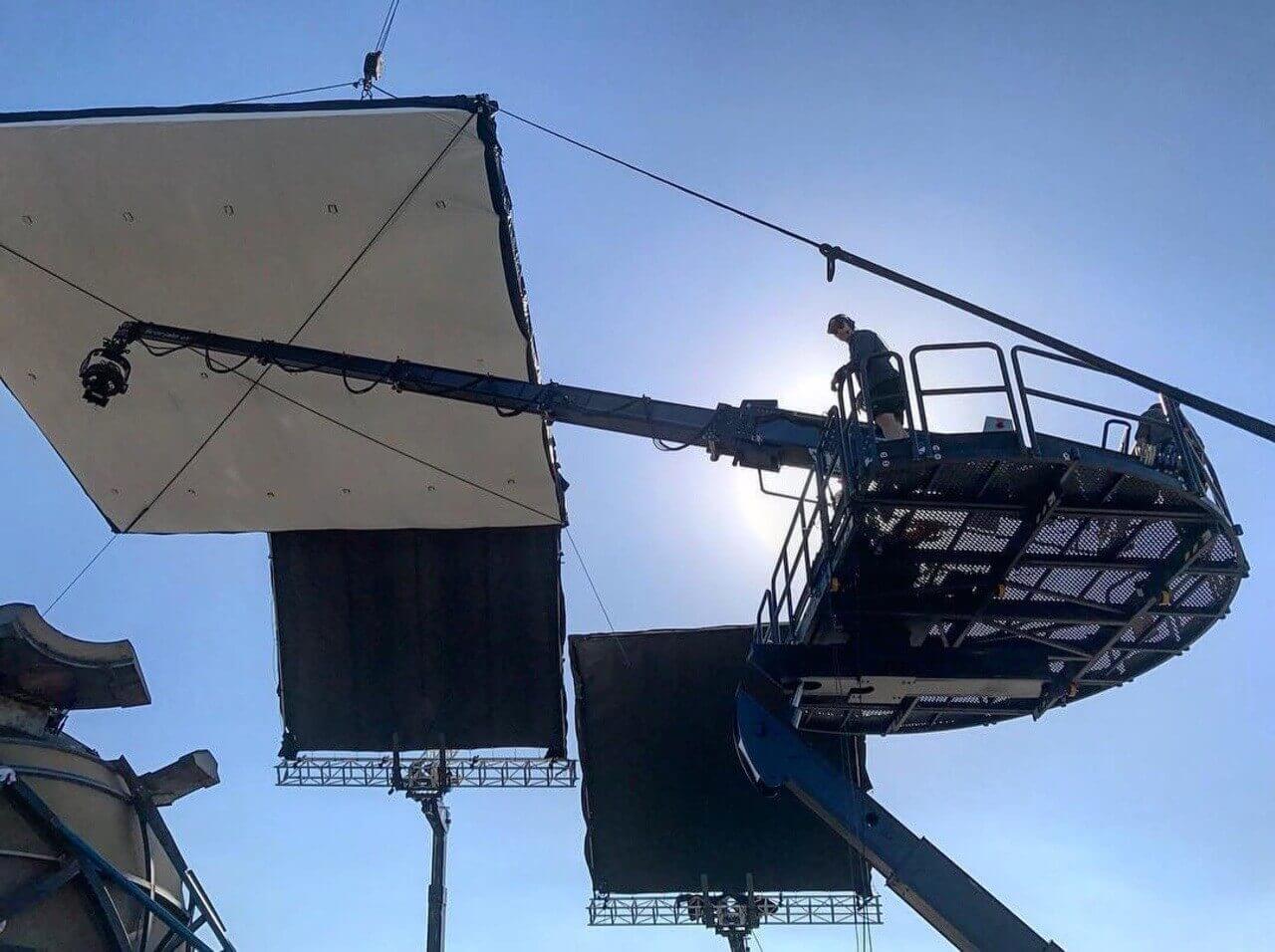
Film Grips might have to build a rig like this
Technically, and especially on union shows, Grips are not permitted to handle any of the actual lighting instruments. A good way to remember this is to think, “Movie Grips don’t have any power."
However, in practice there is a lot of crossover in the Grips department. The common distribution of labor (especially on smaller budget shows) is that part of the Grip film crew works under the Gaffer as Grip-Electric (G/E), and another part of the Grip film crew works under the Key as Riggers. This video explains it a little bit better:
The Film Grip Department Explained
The G/E crew, as managed by the Gaffer and/or Best Boy Electric, position and focus all the actual lights, run cables, and ensure the safety of everyone on set.
Basically, G/E works with anything that requires electricity. So, what is a Grip who’s not working with lights?
Other Grips work with the camera crew and are responsible for things like building dolly tracks for dolly shots, mounting various camera rigs onto cars or setting up for crane shots. A good way to remember this is to think, “Grips rig the set to roll.”
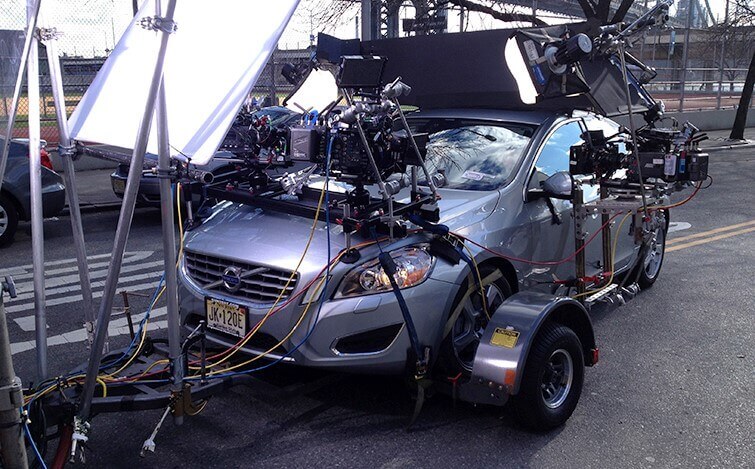
Rigging grips build these camera mounts
And let’s not forget cable pullers, who trail the camera crew and keep the camera/dolly path clear for a smooth shot. So, what’s it like to work as a Grip for film? Let’s discuss that next.
Movie Grip Job Description
Film Grip tools and tips for success
Now, if you’re wondering “what is a Grip’s most important asset?" The most important skills you’ll need to acquire as a Grip in the film industry are strength and stamina. They are often the first part of the crew to arrive on set and the last to sign out for the day.
In between they are constantly on the move.A Movie Grip on set is always on the move
As part of a Film Grip crew, you’ll start the day at the truck, loading out the gear needed for the first setup. You’ll want to make sure you’ve eaten a light, but satisfying breakfast, even if you’re not that hungry.
Side note: Unless it’s a super low-budget project, most of the time the show will provide breakfast for call times before 6:00 am, especially if you’re on a remote location.
During the shoot day, make sure you stay hydrated and pocket some healthy snacks from Craft Services like protein bars or trail mix. And if you see a Production Assistant (PA), don’t be afraid to ask for water.
Part of the Key Grip job is paperwork. After the Key and the Gaffer sign off on the first scene, you’ll either start prepping the next scene (if it’s not on the same set) or they’ll tell you to just stand by.
Standby is no time to take a break. It just means you need to be ready to jump in and make adjustments as soon as they might be asked for. When you do get the chance to sit down for a moment, take it. Those moments don’t come that often. But don’t get so comfortable that you won’t be able to get right back up again.
Once you’re done with everything on the shot list for that scene, you’ll either strike (take down) that setup or head straight to the next one, depending on the size of the crew and/or the day’s shooting schedule.
GRIP FILM TERMS
“Woof!” Nobody knows why we say this — probably because it doesn’t sound like any other instructions — but this is how the Key or Gaffer indicates that you’ve hit the exact spot they’re asking for.
“Walk away.” These are the words you’re waiting to hear from your Gaffer or Key. They simply mean, “Perfect, that’s just what I want.”
To maintain your energy and stamina, the first thing you’ll want to do is invest in is some good shoes. It might sound strange, but good shoes go a long way toward keeping up your energy over a long shooting schedule.
You’re going to be on your feet about 90% of the day, so your work shoes need to be sturdy but lightweight. They should also have good arch support to minimize strain on your back and joints.
Now that we've covered "what does a Grip do," let's talk more specifically about the essential Film Grip tools and equipment. It helps to know some of the basics of the job before you get to the set. So, let’s look at the gear you’ll be using the most.
FILM GRIP SET LIFE
Know your Film Grip equipment list
Any Film Grip equipment list starts with protecting your hands. You’ll want a well-fitting pair of leather Film Grip gloves that both enhance your grip and protect you from injury.
You should also pick up a strong belt that allows you to carry your entire Film Grip tool kit like the one pictured below.
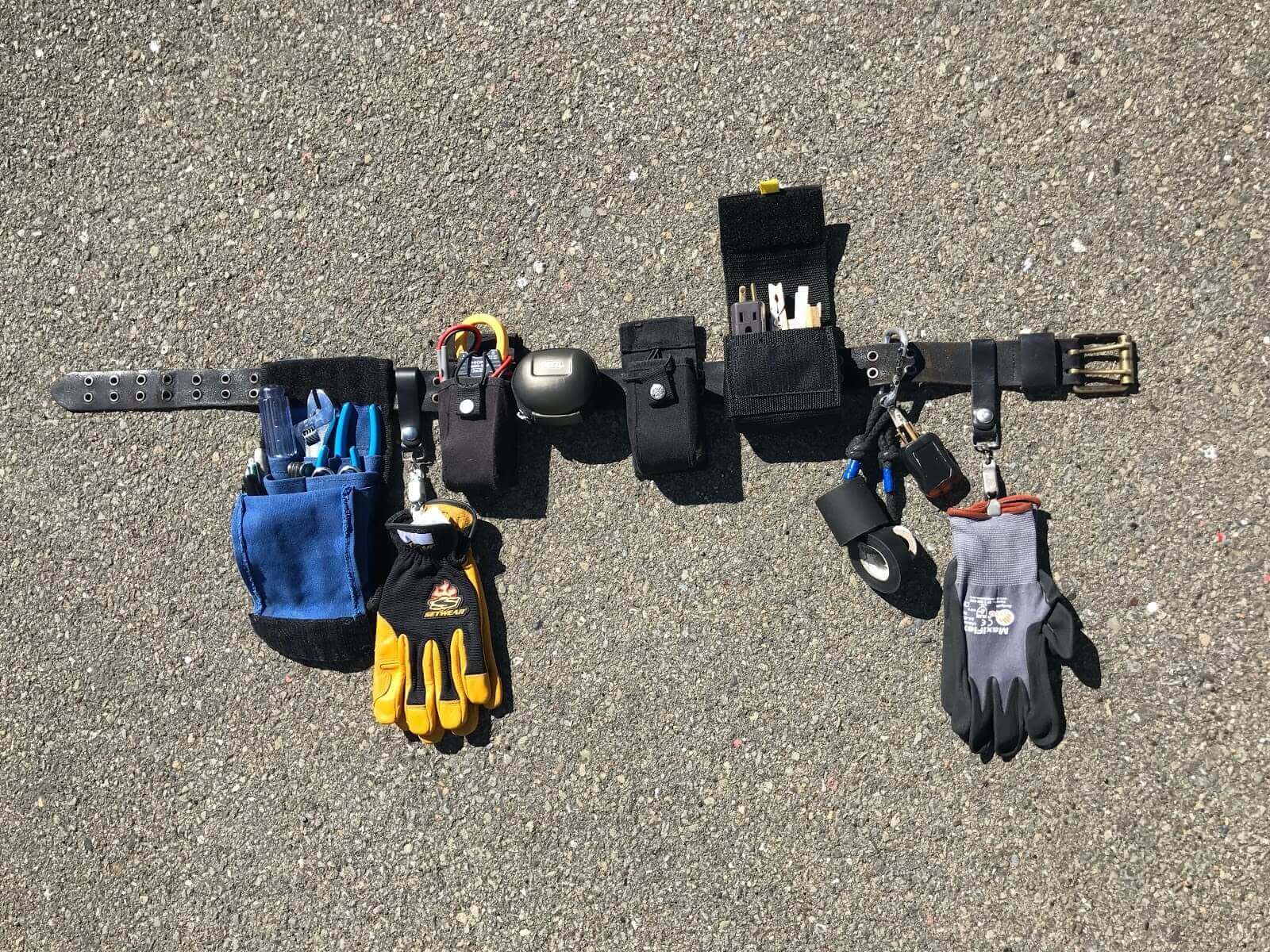
Personalize your Film Grip tool belt
Once the Assistant Director (AD) calls it a wrap for the day, you’ll still have a lot of work to do. Unless you’re specifically instructed to leave everything where it is (“hot set”), you’ll need to bring all the gear back to the truck and put it away.
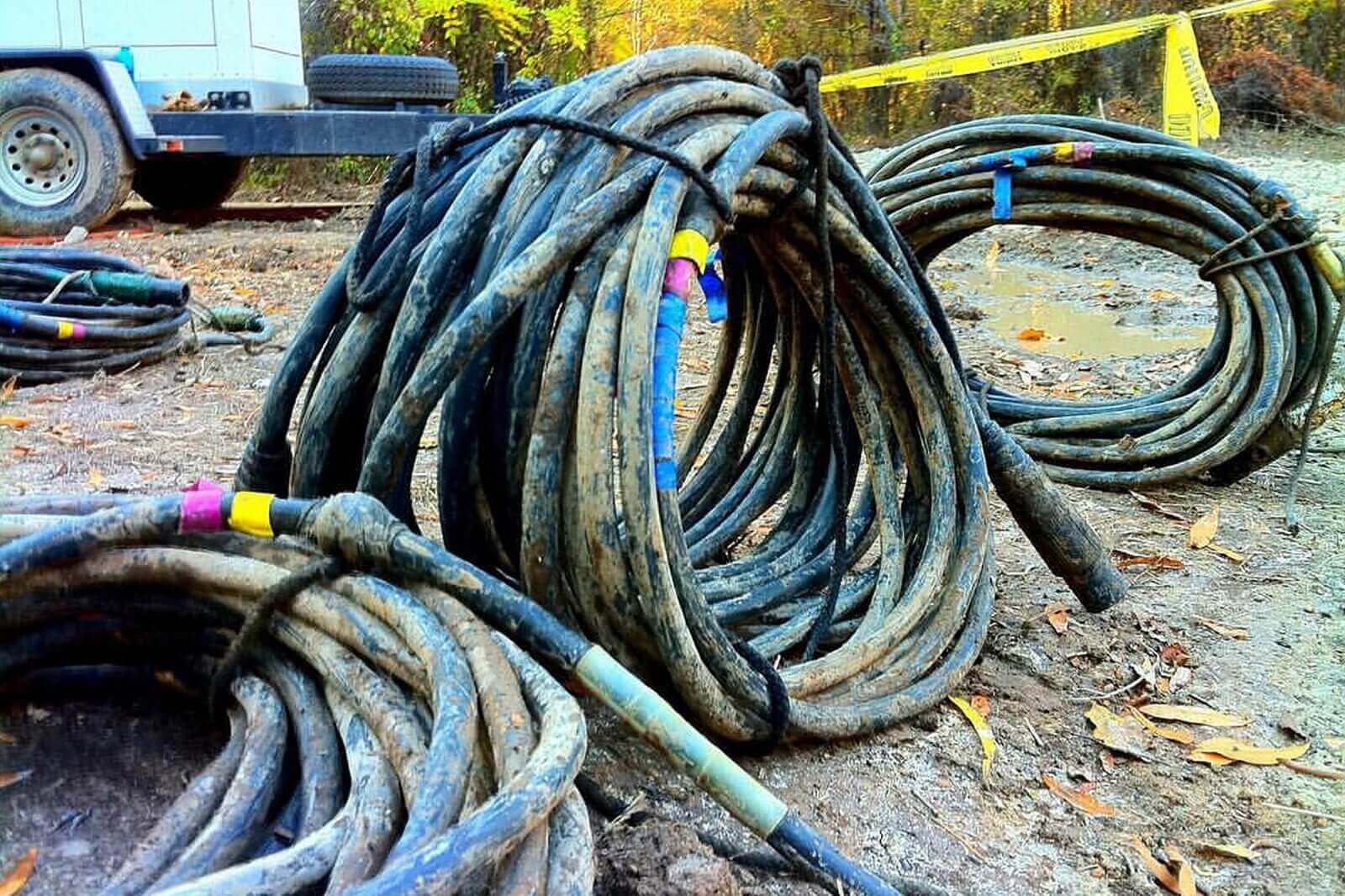
Key Grip Job — Wrapping Cable
There are cables to be coiled, C-stands to be folded up, rigging to be taken down, silks and reflectors to be folded and stashed. And all of that needs to be inventoried to be sure that nothing’s been left out in the wild.
Any damaged gear needs to be reported to the Key Grip, or to whomever the Key assigns to keep track of inventory. As it gets put back on the truck, all the gear needs to stay neat and organized. A disorganized grip truck not only leads to damaged equipment, but also short tempers and production time lost.
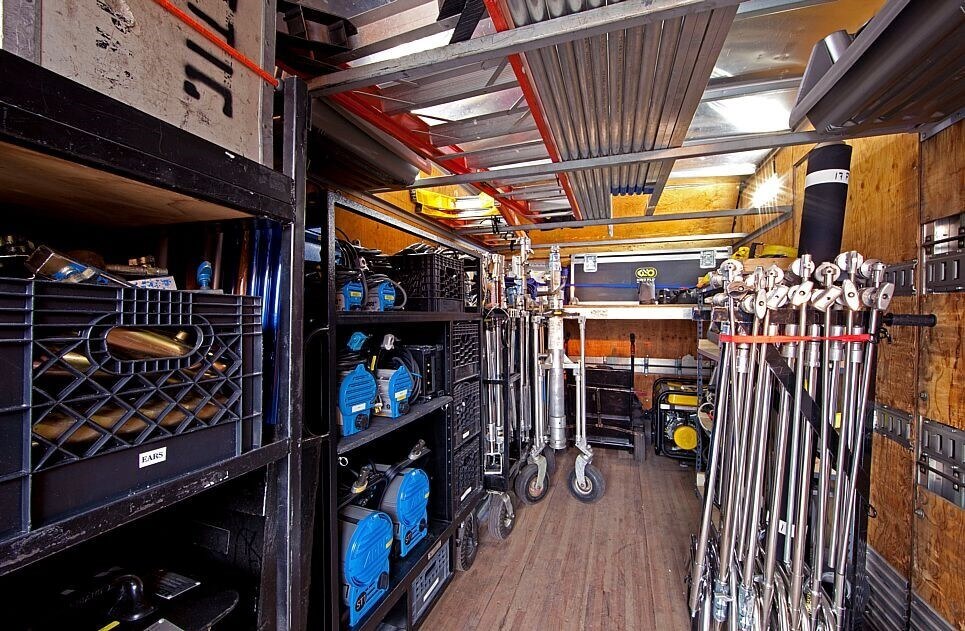
What does a Grip do? Keep the truck organized
But there is one thing that will definitely endear you to the crew, even on your first day: knowing how to properly wrap cable. This video will show you the proper technique, but you’ll still need to take the initiative and practice, practice, practice.
Grip Film Technique 101: How to Wrap Cable
The following list is what you can expect to find in even a small Film Grip equipment list that might be rented for a low-budget show. If you’re unfamiliar with some of these, a quick image search will help.
One thing to note is that there is a lot of slang specific to set life that you’ll pick up as you go along. But a good one to know ahead of time is that a “head” (as in “head cart”) means the lamp itself.
- C-Stand (Century stand) — This sturdy light stand has three different legs that can be adjusted to accommodate steps; a long metal “arm,” and a round clamping head called a gobo.
- Clamps — There are all different kinds of clamps you’ll use on set. Everything from C-47s to Cardellinis and beyond. These hold gels to lights, lights to walls, and diffusion to whatever it takes.
- Cucoloris (“cookie”) — A type of flag with shapes cut into it that creates the look of tree branches, window shades, etc.
- Kino Flo — A bank of fluorescent bulbs used for soft light.
- HMI — A powerful hard light that can be used in place of sunlight.
- Flags — Black, light-absorbing cloth (duvetine) stretched on a metal frame and used to block out areas of light in all different sizes.
- Screens (single, double) — Mesh on a metal frame used to cut the intensity of light without blocking it out.
- Butterfly — A large sheet of fabric used to diffuse a wide area of light.
- Stingers — Extension cords (Practice wrapping them correctly).
- Fresnel — Pronounced “fruh-NELL,” this is a hard-lensed light that comes in different sizes. Each size of fresnel has a different nickname. You’ll learn these on set.
- Barn Doors — A metal frame with metal flaps that attaches to the head. It shapes and focuses the direction of the light.
- Chimera (soft box) — A cloth frame that attaches to a hard light and turns it into diffused light.
- Gels — Colored and transparent sheets that change the color or color temperature of the light.
- Diffusion — Softens the light or knocks down the intensity.
- Gaffer tape — Strong fabric-backed tape that is easily removed when no longer needed. Used for all kinds of things on set.
- Apple box — Different sized (quarter, half, full, pancake) wooden boxes used for a variety of purposes.
The cool thing about being a Grip for film is that it’s the kind of job where you can easily learn everything as you go, and you’ll learn it very quickly. So don’t worry if you’re totally inexperienced.
The veterans will show you what you need to know, along with best practices. Just remember to stay hydrated, stay energized, and pace yourself. Read on for a complete glossary of filmmaking terms.
Related Posts
UP NEXT
What does a Gaffer do?
As mentioned above, one film set position that often gets confused with a Movie Grip is the Gaffer. In this post, we'll cover the essential duties and responsibilities of the Gaffer, and how their role works in conjunction with the Film Grip to create a smooth and efficient production.
Up Next: Gaffer duties explained →
Showcase your vision with elegant shot lists and storyboards.
Create robust and customizable shot lists. Upload images to make storyboards and slideshows.
